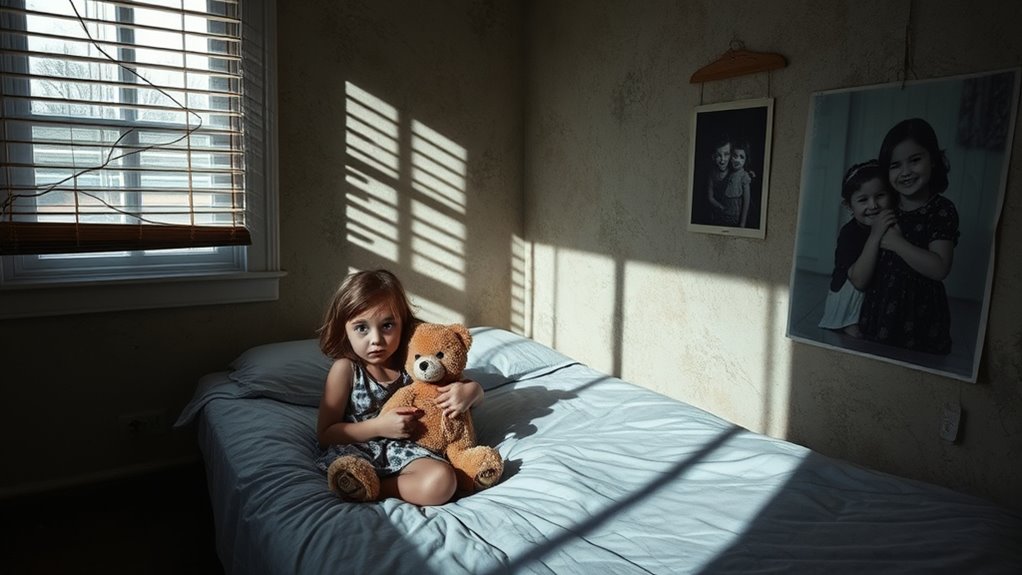Trauma, especially during childhood, plays a key role in developing Borderline Personality Disorder (BPD). Experiences like abuse, neglect, or family instability can disrupt brain development, impair emotional regulation, and foster negative beliefs about yourself and others. These early wounds often lead to intense emotional reactions and trust issues. Understanding how trauma influences BPD can help you recognize its signs and find effective strategies for recovery—if you continue exploring, you’ll discover ways to support healing and resilience.
Key Takeaways
- A significant percentage of individuals with BPD have experienced childhood trauma, such as neglect, abuse, or family dysfunction.
- Childhood trauma disrupts emotional development and brain structures, increasing vulnerability to BPD.
- Trauma-related core beliefs contribute to mistrust, fear of abandonment, and emotional dysregulation in BPD.
- Neurobiological changes from trauma, like altered gray matter and HPA axis dysregulation, influence emotional instability in BPD.
- Recognizing trauma signs is essential for effective BPD treatment and healing processes.
Understanding the Link Between Trauma and BPD

Trauma plays a significant role in the development of Borderline Personality Disorder (BPD), with studies indicating that between 30% and 90% of individuals with BPD have experienced childhood abuse, neglect, or other traumatic events.
Childhood trauma, such as emotional abuse, can disrupt emotional development, making it harder for you to regulate your emotions effectively. Additionally, traumatic experiences can create lasting impacts on brain structures like gray matter and the HPA axis, which are vital for managing stress and impulses. Color accuracy impacts the clarity and realism of visual experiences, which can influence emotional responses to images and scenes.
Childhood emotional abuse hampers emotional growth, challenging your ability to manage feelings effectively.
This trauma impacts brain structures like gray matter and the HPA axis, which are vital for managing stress and impulses. Emotional regulation can be severely affected by these alterations, contributing to the emotional instability characteristic of BPD.
As a result, you may develop negative core beliefs about yourself and others, fueling feelings of unworthiness or mistrust.
These early traumatic experiences hinder emotional regulation and social learning, increasing your vulnerability to BPD symptoms and making it more difficult to achieve stable relationships and emotional balance. Furthermore, understanding how water-based therapies like hydrotherapy can aid in emotional regulation offers promising avenues for treatment and self-care.
Common Types of Childhood Trauma Associated With BPD

Many people with BPD have experienced childhood trauma like neglect or abuse, which can severely impact emotional development. You might also have faced emotional or physical violence or dealt with family members struggling with mental health issues. Recognizing these common experiences helps you understand how they contribute to BPD symptoms. Additionally, humor in communication can serve as a coping mechanism for some individuals dealing with past trauma. Understanding the influence of family dynamics can shed light on the roots of these traumatic experiences and their long-term effects. Research indicates that early exposure to trauma-related stress can alter brain development, further influencing emotional regulation. Moreover, studies show that adverse childhood experiences are strongly linked to the development of BPD later in life. Some research also suggests that emotional neglect can significantly hinder emotional regulation skills, compounding the effects of trauma.
Family Neglect and Abuse
Family neglect and abuse are among the most common childhood experiences linked to the development of Borderline Personality Disorder (BPD). These traumatic events, including emotional neglect and family abuse, often disrupt emotional regulation and foster low self-worth. When caregivers fail to meet emotional needs, it can lead to feelings of abandonment and insecurity that persist into adulthood. The impact varies depending on the type and severity of trauma, but all contribute to difficulties in managing emotions and forming stable relationships. Understanding these common types of childhood trauma is essential for recognizing the roots of BPD. Below is a table highlighting key aspects of family neglect and abuse:
| Type of Trauma | Impact on Emotional Health | Long-term Effects |
|---|---|---|
| Family abuse | Instills fear and mistrust | Chronic anxiety, emotional dysregulation |
| Emotional neglect | Fosters feelings of worthlessness | Low self-esteem, abandonment fears |
| Physical neglect | Leads to safety concerns | Difficulty trusting others |
| Caregiver mental illness | Creates instability | Insecure attachment |
| Family instability | Disrupts emotional development | Poor emotional regulation |
Emotional and Physical Violence
Have you ever wondered how emotional and physical violence in childhood shape the development of Borderline Personality Disorder (BPD)? Exposure to such trauma—like emotional violence or physical abuse—disrupts your emotional development and fosters trauma-related symptoms. Here’s how it impacts you:
- Emotional violence, such as verbal abuse or neglect, undermines your self-identity and heightens fears of abandonment. This type of trauma often leads to difficulties in establishing a stable sense of self, which is characteristic of BPD.
- Physical abuse, like hitting or assault, damages normal emotional regulation and increases vulnerability to BPD.
- Ongoing violence dysregulates your stress response system, making you more reactive to stress, which can contribute to emotional instability. This dysregulation can also impair your ability to manage intense emotions effectively.
- Childhood trauma involving violence impairs social skills and coping strategies, shaping maladaptive patterns seen in BPD. These impairments often hinder healthy relationship development.
- These traumatic experiences can also interfere with your self-esteem, leading to persistent feelings of worthlessness and insecurity. Recognizing the connection between childhood trauma and emotional health can be crucial for understanding and healing from BPD. Additionally, understanding how trauma-related symptoms develop can aid in targeted interventions and recovery strategies.
Caregiver Mental Health Issues
Caregiver mental health issues like depression, anxiety, and substance abuse can profoundly affect a child’s emotional development. When a caregiver struggles with mental health challenges, their emotional availability and responsiveness diminish, disrupting secure attachment and fostering childhood trauma. This inconsistent caregiving creates an unstable family environment, increasing the risk of neglect and emotional invalidation. Children of parents with mental health disorders often experience heightened emotional instability, which impairs their ability to regulate feelings. Maternal mental health conditions, in particular, are linked to higher BPD risk because they interfere with healthy attachment and trust formation. Parental substance abuse can lead to neglect and emotional neglect, further traumatizing the child. These unresolved family trauma issues impair emotional development and lay a foundation for maladaptive coping strategies associated with BPD. Additionally, prenatal stress experienced by the mother can also influence a child’s emotional responses and vulnerability to trauma later in life. Moreover, family environment plays a crucial role in shaping a child’s emotional resilience and susceptibility to trauma. Recognizing and addressing these mental health challenges in caregivers can be vital for preventing the development of trauma-related issues like BPD.
How Early Trauma Impacts Brain Development and Emotional Regulation

Early trauma can profoundly alter how your brain develops, especially in regions responsible for managing emotions. This disruption affects brain development and impairs emotional regulation by weakening neural connectivity between key areas like the prefrontal cortex and amygdala. The consequences include: 1. Altered gray and white matter in emotion-regulation regions. 2. Dysregulated HPA axis, leading to abnormal cortisol levels. 3. Lasting changes in neurotransmitter systems affecting mood and impulses. 4. Reduced ability to control intense emotional reactions. Ongoing research emphasizes the importance of understanding AI safety measures in protecting vulnerable populations from adverse effects. These neurobiological changes from early trauma hinder emotional regulation and social functioning. The lasting impact on neural connectivity makes it harder to process and manage emotions effectively, increasing vulnerability to disorders like BPD. Understanding these effects highlights trauma’s deep influence on brain development.
The Role of Neglect and Abuse in Shaping BPD Symptoms

Neglect and abuse during childhood play a significant role in shaping the core symptoms of Borderline Personality Disorder. Childhood abuse—whether physical, sexual, or emotional—can deeply impact your emotional health, creating lasting trauma.
When your emotional needs go unmet, it hampers your ability to develop healthy social skills, leading to feelings of low self-worth and intense fears of abandonment. Neglect disrupts trust and attachment, making it difficult to form stable relationships later in life. Childhood trauma can interfere with normal emotional development, further complicating interpersonal dynamics, especially when these early experiences hinder the development of trust and attachment in formative years. This disruption can also impair emotional regulation, making it more challenging to manage intense feelings.
Developing cultural intelligence can aid in understanding how early adverse experiences are viewed and processed across different cultural contexts, fostering more effective support and healing strategies. These early experiences influence your interpersonal patterns, often causing you to struggle with intimacy, trust, and emotional regulation. Over time, unresolved trauma from neglect and abuse becomes woven into your sense of self, fueling the instability and emotional turbulence characteristic of BPD. Understanding childhood trauma helps explain how these early adverse experiences shape emotional responses and relational difficulties.
Biological Changes Triggered by Trauma in BPD Patients

Trauma experienced during childhood can lead to significant biological changes in the brain that influence the development of BPD. These changes primarily affect the HPA axis, which controls stress responses, causing abnormal cortisol levels that impair emotional regulation.
Trauma also impacts brain structures by reducing gray matter volume in areas like the prefrontal cortex and amygdala, essential for managing emotions. Neural plasticity plays a role in the brain’s ability to adapt or recover from trauma-related changes.
Disruptions in white matter integrity break neural connections between emotion and impulse control centers, increasing impulsivity and instability.
Elevated cortisol levels impair hippocampal function, affecting memory and emotional processing.
Specifically:
- Dysregulation of the HPA axis alters stress responses.
- Abnormal cortisol impacts brain regions involved in emotion.
- White matter disruptions weaken neural connectivity.
- Changes in brain structures create vulnerabilities in emotional regulation.
- The brain’s adaptive capacity can influence the extent of recovery or persistence of trauma-related alterations.
How Trauma Responses Affect Trust and Relationship Building

Trauma responses can deeply influence how you trust others and build relationships, often creating barriers that make connection difficult. When trauma triggers hypervigilance, you may react strongly to perceived rejection or abandonment, making it hard to form healthy bonds.
These responses can lead you to see others as unpredictable or unsafe, damaging your ability to trust. Trauma can also disrupt emotional regulation, causing intense feelings or suspicion that hinder intimacy.
As a result, you might withdraw or struggle to maintain close relationships, driven by deep-seated fears rooted in past experiences. Over time, these trauma responses reinforce negative beliefs about others and yourself, making relationship building feel overwhelming.
Recognizing how trauma affects trust is an essential step toward healing and creating healthier connections.
The Influence of Family Environment on Trauma and BPD Development

Your family environment plays a vital role in shaping how trauma affects you and may influence the development of BPD. Disrupted relationships or caregiver issues can impair emotional learning and foster feelings of abandonment.
Conversely, a supportive family can help buffer trauma’s long-term impact and reduce BPD risks.
Family Dynamics Impact
Family environment plays a crucial role in shaping emotional development and can markedly influence the risk of developing borderline personality disorder (BPD). Disrupted family relationships, such as parental addiction or mental health issues, impair trust and emotional growth, heightening trauma risk.
Childhood trauma from neglect or instability often leads to maladaptive coping and fear of abandonment. Strong support systems within the family can buffer these effects, reducing long-term difficulties.
Consider these key points:
- Familial instability increases vulnerability to trauma and BPD.
- Childhood trauma disrupts emotional development and trust.
- Poor family relationships hinder healthy coping strategies.
- Supportive family systems help mitigate trauma’s impact.
Childhood Caregiver Influence
The influence of caregivers during childhood plays a critical role in shaping emotional resilience and vulnerability to trauma, which can substantially contribute to the development of borderline personality disorder. When caregiver mental health is compromised, responsiveness and emotional availability decrease, impairing healthy emotional development and attachment.
Children exposed to childhood trauma, such as neglect or abuse, often struggle with trust and self-worth, especially if family instability, like parental addiction or frequent separations, persists. Unresolved family conflicts and grief further undermine a child’s sense of safety, fostering maladaptive coping mechanisms associated with BPD.
When caregivers are emotionally unavailable or mentally ill, children may internalize feelings of abandonment and develop fears of rejection, increasing their risk for trauma-related BPD.
Recognizing Trauma Signs in Individuals With BPD

Recognizing trauma signs in individuals with BPD requires careful observation of their behaviors and emotional responses. Look for patterns that suggest trauma, such as:
Noticing emotional outbursts and dissociation can reveal underlying trauma in individuals with BPD.
- Sudden emotional outbursts, especially when triggered by perceived abandonment or stress.
- Dissociation during intense situations, where they seem disconnected from reality.
- Hypervigilance, appearing overly alert or anxious in familiar or safe environments.
- Self-harm or suicidal ideation, often linked to unresolved traumatic memories.
These behaviors serve as signals that past trauma influences their current state. Being attentive to these trauma signs helps you understand their emotional landscape and provides a foundation for compassionate support and appropriate intervention.
Recognizing these cues is crucial in fostering trust and facilitating healing.
Strategies for Addressing Trauma in BPD Treatment Plans

Addressing trauma within BPD treatment plans requires integrating targeted therapies that directly confront past traumatic experiences. Trauma-focused therapies like EMDR and TF-CBT help reduce symptoms by processing unresolved trauma.
Trauma-informed care emphasizes creating a safe, supportive environment that recognizes trauma’s impact on behavior and responses. This approach helps you feel secure as you explore difficult emotions.
Improving emotional regulation is key, so strategies that build this skill are essential.
Additionally, addressing attachment patterns through family therapy can repair disrupted relational bonds caused by childhood trauma.
An all-encompassing treatment plan combines these approaches to target core issues, lowering the risk of self-harm and promoting recovery.
Long-Term Recovery and Healing Through Trauma-Informed Care

Long-term recovery from BPD relies on trauma-informed care that emphasizes understanding how childhood and family trauma shape current behaviors and emotional responses. This approach promotes compassion and tailored treatment, addressing unresolved trauma directly.
To foster healing, focus on:
- Developing emotional regulation skills through therapies like DBT
- Integrating trauma-focused interventions to process unresolved trauma
- Building supportive relationships with family and social systems
- Ensuring treatment integration to maintain consistency and safety
Frequently Asked Questions
Is BPD Linked to Trauma?
You might wonder if there’s a connection between BPD and trauma. Research shows a strong link, with many individuals having experienced childhood abuse or neglect.
Trauma affects brain areas involved in emotions, making you more vulnerable to BPD symptoms. It can also shape negative beliefs about yourself and others, influencing how you relate to the world.
Recognizing this link can help you better understand your experiences and seek appropriate support.
Why Do Therapists Avoid BPD?
You might think therapists avoid challenging cases because they’re unwilling to help, but often it’s about fear and misconceptions. Many believe BPD is untreatable or too difficult, which isn’t true.
They worry about safety risks, emotional burnout, or lacking the proper training. This fear and misunderstanding can make them hesitant to engage fully, even though with the right approach, they can effectively support those with BPD.
What Is the Life Expectancy of Someone With BPD?
You might wonder about life expectancy, and it’s important to know that individuals with BPD typically face a shorter lifespan, about 10-15 years less than the general population.
This increased risk is mainly due to high rates of suicide and self-harm.
However, early diagnosis and proper treatment can help improve your quality of life and potentially extend your lifespan, making proactive care essential.
What Are the 3 C’s of BPD?
Did you know that understanding the 3 C’s can markedly improve emotional well-being? The 3 C’s are Changes in mood, Conflicts in relationships, and Control issues with impulses and emotions.
You might notice rapid mood shifts, unstable relationships, or difficulty managing urges. Recognizing these signs helps you or someone you care about seek targeted support, leading to better emotional regulation, stronger relationships, and healthier impulse control.
Conclusion
Understanding the link between trauma and BPD helps you heal more holistically. By acknowledging abuse, abandonment, and adverse experiences, you can begin addressing underlying wounds. Remember, recovery requires patience, persistence, and a compassionate connection. Embrace empathy, educate yourself, and engage in trauma-informed treatment. With courage and consistency, you can confront, cope, and eventually conquer the chaos, creating a clearer, calmer, and more compassionate core for your continued journey.
Isla’s writings reflect a profound connection to the BPD community, offering solace and understanding to those who feel isolated by their struggles. Her articles explore the nuances of relationships, healing, and self-discovery, all through the lens of BPD. Isla’s compassionate approach to storytelling encourages readers to embrace their journey with hope and resilience.










